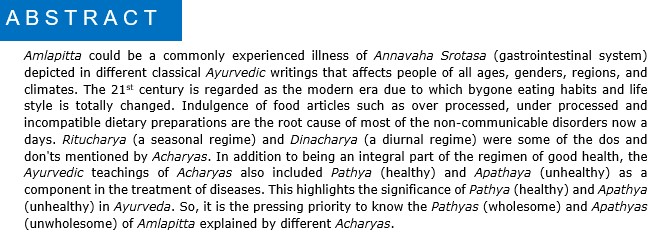A review on Ayurveda dietetics for Amlapitta (Gastroesophageal Reflux Disease) by different Ayurveda classical texts
DOI:
https://doi.org/10.21760/jaims.8.11.21Keywords:
Amlapitta, Diet, Food, Pathya, ApathyaAbstract
Amlapitta could be a commonly experienced illness of Annavaha Srotasa (gastrointestinal system) depicted in different classical Ayurvedic writings that affects people of all ages, genders, regions, and climates. The 21st century is regarded as the modern era due to which bygone eating habits and life style is totally changed. Indulgence of food articles such as over processed, under processed and incompatible dietary preparations are the root cause of most of the non-communicable disorders now a days. Ritucharya (a seasonal regime) and Dinacharya (a diurnal regime) were some of the dos and don'ts mentioned by Acharyas. In addition to being an integral part of the regimen of good health, the Ayurvedic teachings of Acharyas also included Pathya (healthy) and Apathaya (unhealthy) as a component in the treatment of diseases. This highlights the significance of Pathya (healthy) and Apathya (unhealthy) in Ayurveda. So, it is the pressing priority to know the Pathyas (wholesome) and Apathyas (unwholesome) of Amlapitta explained by different Acharyas.
Downloads
References
Meenakshi K, Vinteshwari N, Minaxi J, Vartika S. Effectiveness of Ayurveda treatment in Urdhwaga Amlapitta: A clinical evaluation. J Ayurveda Integr Med. 2021 Jan-Mar;12(1):87-92. doi: 10.1016/j.jaim.2020.12.004. Epub 2021 Feb 3. PMID: 33546994; PMCID: PMC8039346.
Murthy S.K., Madhavakara. Madhava Nidana. 2011th ed. Chaukambha Orientalia, Varanasi, 2011;p.166-7.
Agnivesha, Charaka, Chakrapani. SutraSthana. Chapter 25, Verse46. In: Sharma RK, Dash B (editors). Charaka Samhita with Chakrapaanidatta, Ayurved Dipika, Commentary. Reprint ed. Varanasi: Chowkambha Sanskrit Series. Volume 1, 2012;p. 438.
Antunes C, Aleem A, Curtis SA. Gastroesophageal Reflux Disease. [Updated 2023 Jul 3]. In: StatPearls [Internet]. Treasure Island (FL): StatPearls Publishing; 2023.
Kumar HK, Sridurga CH, Rao DB. Clinical efficacy of Baladi Manduram in the management of Amlapitta. Ayu. 2017 Jul-Dec;38(3-4):133-138. doi: 10.4103/ayu.AYU_201_17. PMID: 30254393; PMCID: PMC6153916.
Clarrett DM, Hachem C. Gastroesophageal Reflux Disease (GERD). Mo Med. 2018 May-Jun;115(3):214-218. PMID: 30228725; PMCID: PMC6140167.
Hansen KE, Jones AN, Lindstrom MJ, Davis LA, Ziegler TE, Penniston KL, Alvig AL, Shafer MM. Do proton pump inhibitors decrease calcium absorption? J Bone Miner Res. 2010 Dec;25(12):2786-95. doi: 10.1002/jbmr.166. Epub 2010 Jun 24. Erratum in: J Bone Miner Res. 2011 Feb;26(2):439. PMID: 20578215; PMCID: PMC3179281.
Madhavanidana of Shri Madhavakara with Madhukosa Sanskrit Commentary by Sri Vijayaraksita and Sri Kanthadatta with the Vidyotini Hindi Commentary by Sri Sudarasanasastri and Edited by Prof. Yadunandana Upadhyaya Part-II, Chaukhambha Prakashan Reprint Year (2014)51/1 Page No.-202.
Kasyapasamhita by Vrddhajivaka by Pandit Hemraj Sharma with the Vidyotini Hindi Commentary by Satyapalabhi sagacharya Reprint Year (2018) Chaukhambha Sanskrit Sansthan Khilasathana 16/7-13 Page No. 514
Agnivesha, Charaka, Chakrapani. SutraSthana. Chapter 25, Verse 45. In: Sharma RK, Dash B (editors). Charaka Samhita with Chakrapaanidatta, Ayurved Dipika, Commentary. Reprint ed. Varanasi: Chowkambha Sanskrit Series. Volume 1. 2012;p.437















